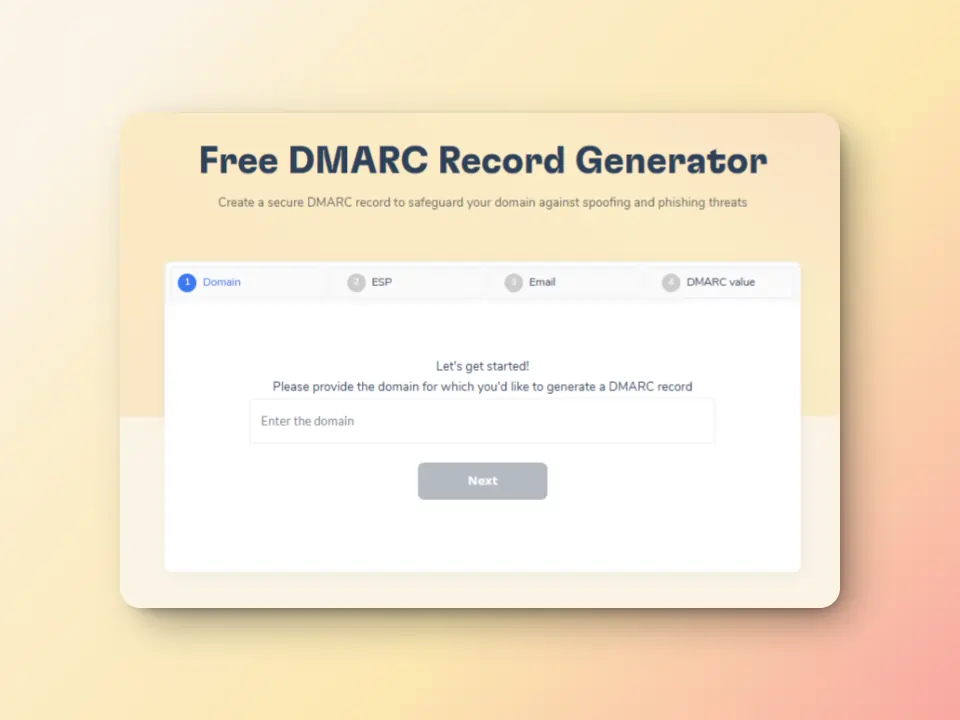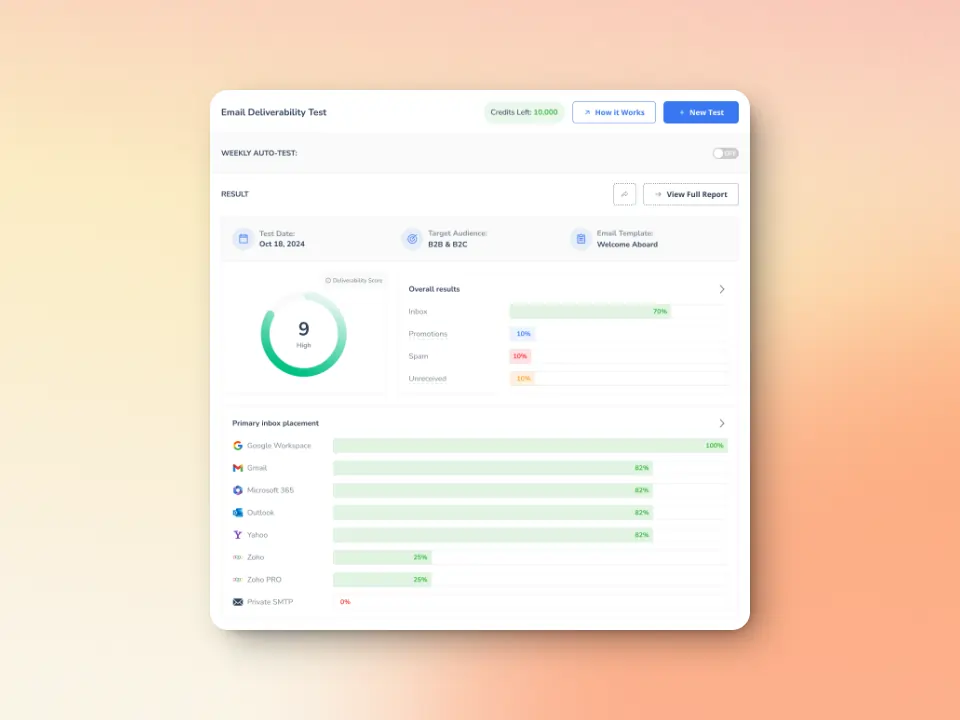If you’ve ever encountered an error message like “SMTP Error 450 4.1.8 Sender address rejected: Domain not found,” after sending an email, you might be wondering what happened.
While this error is a temporary failure, it can still cause inconveniences, delays, and frustrations. Thus, it’s essential to address this error as soon as possible.
Understanding and resolving this error is crucial to ensuring that your emails are properly authenticated, and your domain remains in good standing with email providers.
What is SMTP Error 450 4.1.8?
SMTP error 450 4.1.8 is a temporary failure that indicates your email was rejected by the recipient’s mail server. Yes, it’s a temporary error—but it can often point to a fundamental issue.
Basically, what happened is the recipient’s email server could not find the domain of the sender’s email address in the DNS (Domain Name System). When this happens, your emails can be classified as spam, blocked entirely, or temporarily rejected with this 450 4.1.8 error.
What causes SMTP Error 450 4.1.8?
To illustrate, here’s what occurs behind the scenes:
- DNS Lookup Initiated: When a recipient’s mail server receives an incoming email, one of its first tasks is to verify the legitimacy of the sender’s domain.
- Failure to locate domain: The server attempts to perform a DNS lookup on the domain in the MAIL FROM address or, in some cases, the From header domain.
- Missing DNS Records: If the server cannot find corresponding DNS records for the sending domain, it triggers the ‘domain not found’ error. This is often because of missing or misconfigured DNS records.
Understanding the crucial role of DNS records in mitigating SMTP Error 450 4.1.8
As mentioned above, SMTP error 450 4.1.8 is often caused by issues with domain authentication and DNS records. Here, we discuss how various DNS records impact deliverability.
The role of domain authentication in email delivery
Domain authentication is the process of verifying whether an email is truly coming from the domain it claims to be from. It helps mail servers identify legitimate senders and prevent malicious or spammy emails from reaching inboxes.
When you authenticate your domain, you provide proof that you own the domain and have the right to send emails from it. This also helps avoid spoofing incidents.
While the SMTP error 450 4.1.8 isn’t really about authentication protocols like SPF, DKIM, and DMARC, these records still contribute when it comes to confirming a domain’s existence.
So if domain authentication records are missing, misconfigured, or expired, the recipient’s email server may find it difficult to verify the domain. This can then lead to errors like 450 4.1.8. This is particularly problematic because an unverified domain may be flagged as suspicious or potentially dangerous.
What are the essential DNS records for email sending domains?
Mail servers look for specific record types to confirm a domain’s existence and its ability to handle email:
- MX (Mail Exchanger) records: This tells other mail servers where to route emails for your domain. Even if you’re sending an email and not receiving it, many recipient mail servers still conduct this check to determine if the sending domain is legitimate.
- A (Address) and AAAA (IPv6 Address) records: The A record maps a domain map to an IPv4 address, and an AAAA record to an IPv6 address. It’s an additional anti-spam measure that recipient mail servers do to protect their users by confirming that the domain actually exists.
- Sender Policy Framework (SPF) and DomainKeys Identified Mail (DKIM): These are both crucial records for email authentication. They don’t directly cause the SMTP Error 450 4.1.8 “domain not found” issue, but they still play a crucial role in verifying your legitimacy and trustworthiness.
How to resolve the 450 4.1.8 Error
To fix this issue, you’ll need to verify that your sending domain is properly configured and publicly resolvable. The steps below walk you through how to diagnose, correct, and prevent this issue.
Perform a DNS lookup for your sending domain
The first and most important step you need to take is to confirm that your sending domain has valid, publicly visible DNS records. Check the MX, A, and AAAA records not only for your primary sending domain (e.g., ml.example.com) but also for related hostnames (e.g., mtaX.ml.example.com).
Recommended tools:
- dig
- Nslookup
Example commands:
- dig MX yourdomain.com
- dig A yourdomain.com
- dig AAAA yourdomain.com
Verify DNS propagation
DNS changes can take time to propagate globally. The timeframe can be anywhere from a few hours to 24–48 hours. So if records were recently added or modified, recipient servers may still be seeing outdated DNS data.
What you should do: If everything appears configured correctly, propagation delay may be the temporary cause. You can wait it out for a set amount of time before troubleshooting again if the error persists.
Check essential DNS records
At minimum, check if your MX records exist and if they point to your mail server. Also take a look at your A/AAAA records, and review if your SPF, DKIM, and DMARC protocols are valid and published. Don’t forget to verify DNS records for all domains or subdomains involved in your sending pipeline.
Quick note: Even if SPF/DKIM pass, missing MX or A/AAAA records can still trigger a 450 4.1.8. Domain resolvability must be correct first.
Confirm proper configuration on authoritative DNS nameservers
Make sure your authoritative DNS servers are serving the correct data. If they are misconfigured, inconsistent, or out of sync, some receiving servers may fail DNS lookups.
Consider temporary network or recipient-side issues
Because 450 is a temporary error, other causes include recipient DNS glitches, momentary network failures, and receiver server overload. If your DNS is correct, simply waiting and retrying may resolve it.
How Warmy can help prevent future SMTP 450 4.1.8 errors
The SMTP error 450 4.1.8 – Sender address rejected: Domain not found doesn’t just block an email. It signals a foundational DNS problem that can hurt your overall email deliverability.
When receiving servers cannot find your sending domain, they may treat this as a red flag.That can lead to increased bounces, more messages going to spam, blacklisting, and long-term reputation damage.
DNS configuration, authentication, and domain reputation are all interrelated, meaning this error has a role to play when it comes to maintaining inbox placement.
Warmy.io provides a comprehensive set of tools and automated processes designed to keep your sending infrastructure healthy and help ensure your domain is always properly authenticated.
Domain Health Hub

Instead of monitoring individual email addresses, Warmy.io provides a domain-level health dashboard. The Domain Health Hub shows the following features:
- A domain health score based on various factors like authentication, blacklist status, and inbox placement tests.
- Spam rate trends and overall deliverability performance with weekly or monthly tracking options.
- Comprehensive DNS status checks to easily validate SPF, DKIM, DMARC, rDNS, MX, and A records for stronger authentication & security.
- Optimized multi-domain monitoring so users can manage all their domains from one dashboard and identify which ones need immediate attention.
- Quick access to a detailed breakdown of health metrics, performance reports, and deliverability trends per domain.
By monitoring your setup, Warmy helps prevent the configuration drift that leads to DNS-related failures.
SPF and DMARC Record Generators

One of the strongest defenses against deliverability issues is proper authentication. Warmy’s free SPF Record Generator ensures SPF is valid and includes the correct authorized senders. On the other hand, the free DMARC Record Generator ensures DMARC policies are correctly set and aligned
Continuous inbox warmup & reputation building

If DNS or authentication issues have damaged your sender reputation, Warmy’s automated email warmup helps repair it by generating trusted, positive engagement (opens, replies, and importance marks). This helps improve how mailbox providers perceive your domain and supports recovery after DNS-related disruptions or SMTP errors.
Email deliverability test

Warmy.io’s Email Deliverability Test gives a comprehensive report of the percentage of your emails landing in the inbox, promotions, spam, and even the unreceived ones. It also reveals if your domain or IP is included in any blacklists which can happen if your email content is continuously rejected by recipients’ servers.
The test also checks your email authentication settings (SPF, DKIM, and DMARC) if they are properly authenticated.
Avoid SMTP error 450 4.1.8 and take a proactive approach to email deliverability
SMTP error 450 4.1.8 – Sender address rejected: Domain not found can be a major roadblock to successful email campaigns, but it’s entirely preventable with the right approach and strategies discussed above.
Taking a proactive approach to email health not only prevents SMTP errors but also ensures that your emails reach your recipients’ inboxes consistently. Warmy’s tools help automate and streamline the process of maintaining domain health, verifying authentication, and continuously monitoring your deliverability, so you can focus on engaging with your audience without worrying about email errors.
Ready to take control of your email deliverability? Start your free trial with Warmy today.
FAQ
What does SMTP error 450 4.1.8 mean?
This error indicates that the recipient’s mail server couldn’t locate or resolve the sender’s domain in the DNS.
Is SMTP error 450 4.1.8 a permanent error?
No. The 450 prefix means it’s a temporary deferral. Your server will retry sending the email. However, if the underlying DNS issue isn’t fixed, the temporary failure can eventually turn into a permanent bounce.
Can SPF or DKIM fix SMTP 450 4.1.8 errors?
SPF and DKIM help authenticate your email, but SMTP 450 4.1.8 occurs when the domain cannot be found in the DNS. You must first fix missing or incorrect MX, A, or AAAA records before authentication can help.
How can Warmy help prevent SMTP 450 4.1.8 in the future?
Warmy continuously monitors your domain health, DNS configuration, and authentication records (SPF, DKIM, DMARC). The platform alerts you to issues early and improves your sender reputation through automated warm-up, helping prevent errors related to DNS or deliverability.








![Texto en español: “Bandejas de entrada. Por qué mis correos no llegan a la bandeja de entrada [CAUSAS]” sobre un fondo blanco con degradado naranja en la esquina inferior derecha.](https://warmy-blog-wordpress-bucket.s3.amazonaws.com/wp-content/uploads/2025/11/05221150/Mockup3-74.avif)



